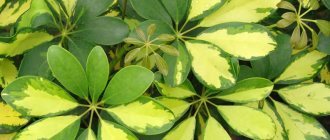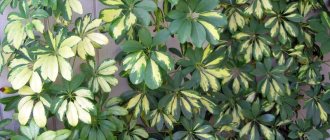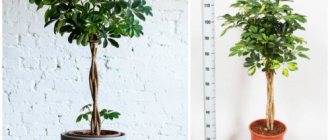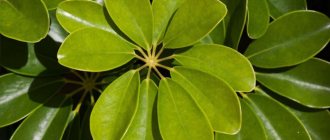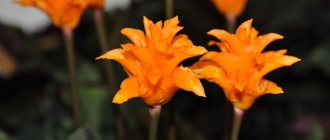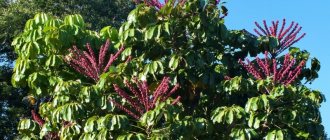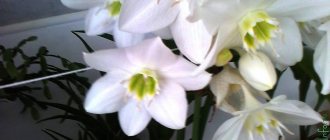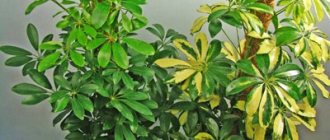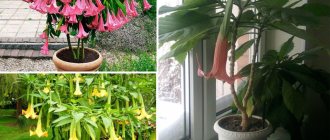/Accessories and decor/Gardening/
Schefflera (or shefflera, as they often look for it in search engines, having lost the second “f”) is a beautiful and literally friendly plant: its unusual leaves resemble a palm that you just want to shake. Somewhere in the world another unofficial name has taken root - “umbrella” or (even cuter) “gnome’s umbrella”.
Although you can’t expect schefflera to bloom in an apartment, the bright foliage of a neat bush itself greatly decorates the space. Moreover, the flowering of Schefflera is very inconspicuous, and the berries that may form are completely poisonous. They can be safely removed when formed.
The best qualities of shefflers:
- To the delight of all tea gardeners, caring for shefflera at home is elementary;
- You can form a fancy stem by planting several young plants while they are flexible;
- If all conditions are met, you can grow a fairly tall (up to one and a half meters) and lush tree. This is how a potted plant has a chance to become an outdoor plant;
- Often the plant is placed in rooms where tobacco smoke penetrates. It is believed that shefflera firmly takes the blow: it neutralizes resins and ozonizes the air;
- A certain type of Schefflera is suitable for practicing the art of bonsai.
For mini-tree lovers, this is a must have!
Important: the juice of schefflera leaves can cause irritation, so prevent children from botanical experiments and cats’ pranks.
Lighting
Schefflera is moderately demanding of good lighting and will happily extend its palm-shaped leaves to the light. The ideal window is southern, acceptable are western and eastern.
Advice: if you want to have this plant, but the room is annoyingly dark, or the pot will be located not on the window, but in the back of the room, choose green rather than variegated types of schefflera. Variegated Schefflera have higher light requirements than regular green ones.
In the summer, the plant will be comfortable moving into fresh air. Watch out for scorching rays: they can burn the leaves, so take care of shading the bush during the active time of the sun.
Temperature
Room temperature is quite suitable for the plant, so it can comfortably coexist with you in an apartment.
In the cold season, shefflera does not mind lowering the temperature to 16 degrees, but not colder.
Like other indoor plants, the bush should be protected from drafts and proximity to heating devices.
Watering
Schefflera will remind you about watering itself - as soon as the top layer dries, it means watering is required. It is easy for Schefflera to be ruined by both overwatering and drying out, so strike a balance and keep an eye on it.
An approximate watering schedule in the warm season is once every two days. In winter - moderate watering every 5-7 days.
Focus on the conditions under which the plant is kept, because... In different houses the soil dries out faster or slower.
You can use a life hack: place the pot on a tray with expanded clay, periodically watering the stones. The necessary moisture will rise to the ground, and the excess will evaporate.
Important: to water all indoor plants, you should use only settled water at room temperature. Watering directly from a cold tap can quickly affect the health of the plant.
Schefflera - description and origin, photo
From a botanical point of view, a representative of the Araliaceae family forms three forms - tree, shrub or vine - depending on the species. What makes it especially attractive are the leaves, which look like open palms and are colored in emerald tones, and in some varieties there is also a variegated color - light green spots on a darker green background.
In the wild, exotic grows in the rainforests of tropical Southeast Asia, Australia and Oceania. Under natural conditions, its height reaches 40 m (trees), but in domestic conditions it rarely exceeds the two-meter mark.
Interesting! Schefflera, growing at home, is able to absorb negative energy and smooth out conflict situations.
The flower was named in honor of Jacob Christian Scheffler, the German botanist who described it. Although keeping indoor varieties requires maintaining certain conditions, the plant is unpretentious and easily adapts to some deviations from the regime. The following types are popular in home floriculture:
- Shefflera digitate – shefflera palmata;
- Sh. actinophylla – Sh. radiate (star-leaved);
- Sh. octophylla – Sh. eight-leaved, or “octopus”;
- Sh. Arboricola – Sh. woody.
Particularly decorative varieties:
- Shefflera Bianka - Shefflera Bianka, the color of the leaves is light emerald with a cream edge.
- Sh. Gemini - Sh. Gemini, emerald leaves have a central reddish stripe.
- Sh. Gold Capella - W. Golden Capella - with lemon-yellow spots on bright green leaf blades.
Humidity
Schefflera has lush green foliage and will not mind frequent misting. In its native conditions, it requires a lot of moisture, so it’s a good idea to create the illusion of it at home and in the apartment.
In hot weather or when heating devices are working intensively, you can spray the foliage once every two days. The water in the spray bottle should also be settled. Cold, hard tap water is stressful not only for the roots, but also for the foliage.
Additional humidification can be connected using a tray with wet expanded clay in which the pot is installed.
A less aesthetic, but quite convenient method is a wet cloth on batteries. All this will be useful if the sheffler is located directly above a hot radiator.
Rest period
Schefflera “falls asleep” for the winter, stopping its growth. There is no need to put it away in the dark, but it would be good to reduce the temperature in the wintering room to 14-16 degrees.
Watering the shefflera during the winter holidays is also reduced: do not water it out of habit with the usual frequency.
See also:
- Anthurium - home care guide
- Caring for indoor hydrangea at home
- How to care for dracaena at home
- Caring for Zamioculcas (dollar tree) at home
- How to care for begonia at home
- How to care for a money tree (crassula)
- How to care for myrtle at home
- How to care for hibiscus (indoor Chinese rose) at home
- How to care for Kalanchoe at home
- Tree in the room: how to care for Ficus Benjamin at home
- How to care for geraniums at home - a guide for beginners
- How to care for orchids - 7 steps for a beginner
- How to care for violets at home
Description of the flower
Tree varieties are most often grown at home. Among the 600 species, there are liana and bush specimens, both with green and variegated leaves. It is the bizarre shape of the plates that attracts everyone's attention to the sheffler. Each leaf consists of several (from 3 to 12) palmate segments on thin long petioles, which, due to their arrangement, resemble an open umbrella.
Shefflera is native to the tropical forests of Australia, New Zealand, as well as Southeast Asia, the Malay Archipelago and Indonesia.
In its natural environment, the plant settles on the trunks of large trees in order to be as close to the light as possible.
Many people are interested in whether sheflera blooms at home? In this regard, it is worth saying that budding is practically not observed indoors. But in natural conditions, it produces inflorescences in the form of huge panicles or brushes resembling tentacles. For this feature it is often called the octopus tree.
Even without flowers, Schefflera is a real decoration for any private collection.
Transfer
Schefflera transplant schedule at home:
- It is good to replant a young plant that is actively growing once a year in the spring;
- Adult - once every few years.
Each time when replanting schefflera, we choose a pot larger than the previous one (at least 5 cm). Any ready-made soil mixture intended for ornamental foliage plants is suitable. You can also prepare the substrate for transplanting schefflera yourself using this recipe: drainage + turf soil (2 parts) + leaf soil (1 part) + distilled soil (1 part) + sand.
How to replant a Schefflera: carefully roll the bush along with a lump of earth and place it in a larger pot with drainage and fresh soil.
Important: this “relocation” option is suitable for healthy plants. If, due to excess moisture, the roots of the schefflera have rotted, you need to free them from the old soil, carefully inspect and cut off the damaged ones.
What size pot is needed for cheflera? How to care for sheflera at home
The shefflera flower is considered tropical, so it grows well on a bright windowsill and indoors.
It is not recommended to place it in the sun so that the leaves do not lose their decorative appearance from sunburn. In summer, the sheflera can be taken outside or placed on the balcony.
In winter, you should leave it alone, so it is better to move the pot with it to a cool room and reduce watering.
Like all tropical plants, shefflera prefers moist air. In this regard, there is a need to spray it more often in the summer. In winter, radiators dry out the air very much, so you need to place wet pebbles near the plant.
Caring for a cheflera at home is not particularly difficult, as it looks at first glance. This flower will be an excellent decoration for your room if you follow simple rules:
- do not overfill water while watering;
- do not allow the soil to dry out completely;
- do not keep it in a dark corner;
- create space for growth around.
There are several ways to propagate the plant. The most common is using cuttings. It is not easy to achieve the appearance of roots, so the cutting is kept in a root growth stimulator for about 6 hours.
At this time, it is necessary to prepare a pot, at the bottom of which it is advisable to place a thin layer of drainage and soil consisting of a mixture of peat and river sand.
After the time has passed, the cuttings are planted in a pot and covered with a glass.
The container with the plant must be placed on a warm and bright windowsill, where the air temperature should not fall below 22-25 degrees Celsius. Sometimes it is advisable to open the jar to ventilate the Schefflera flower, the photo of which is located below. You can also spray it with a spray bottle. The water must be warm.
Another method is propagation by seeds. To do this, they are purchased at a flower shop and treated with epin or potassium permanganate. Planted in soil consisting of peat and sand, to a depth of about 15 centimeters in moist soil, covered with glass on top. After the shoots emerge, they are cared for in the same way as cuttings. Wherein:
- ventilate;
- watered;
- loosen the ground;
- sprayed.
As soon as the sprouts grow to about 10 centimeters, they are transplanted into separate containers.
As the flower grows, it is necessary to transplant it into a larger pot. How to care for sheflera during transplantation? To do this, you need to take it out along with a lump of earth and transplant it into a container that is 3 cm larger in diameter. Such transshipment must be carried out every 2 or 3 years. After transplanting, it is advisable to water the plant well.
Flower growers often ask the question, why does shefflera shed its leaves? Like most plants, this flower is susceptible to various diseases.
When sheflera sheds its leaves, the cause of such troubles is growing indoors with high humidity and excessive watering, which leads to rotting of the roots. The indicator will be the resulting dark spots on the leaves.
When watering is reduced, the plant becomes richly green again. But just in case, you need to check the condition of the roots.
In addition, the plant is attacked by harmful insects: thrips, spider mites, scale insects. What to do if the cheflera sheds its leaves due to a pest attack? To combat them, it is necessary to use various chemicals: karbofos, fitoverm and others.
If the shefflera sheds its leaves and they begin to turn yellow, there may be several reasons for this. One of them is poor lighting. Therefore, it is advisable to move the plant to another place where there is more light. Another reason why Schefflera leaves fall may be mites, which usually hide under the leaves.
By following the growing rules and recommendations, you can get a beautiful plant that will always delight you with its appearance.
- This flower is considered a symbol of prosperity and wealth. It is often bought to attract the energy of money into the house.
- Charges the room in which it is located with positive energy.
- The plant brings good luck in business to the fire signs of the Zodiac: Sagittarius, Leo and Aries. It becomes their kind of amulet.
on this topic
Schefflera is an original tree-like plant of the Araliaceae family with dark green leathery leaves collected in characteristic “umbrellas”. There are also variegated species with white and yellow spots.
The plant's homeland is the humid subtropical forests of Southeast Asia. In indoor conditions, with good care, the cheflera reaches 2 m in height. To avoid excessive growth and form a lush crown, the apical shoots of the tree are pruned.
From such shoots you can try to grow sheflera yourself.
Instructions
So, the shefflera pruning has taken place, and you have received the long-awaited apical shoot. Using a sharp knife, cut it into cuttings about 10 cm long. Place them in a jar of boiled water. To avoid rotting, it is recommended to add a little crushed activated carbon to the water. Cover the jar with a transparent plastic bag so that the liquid evaporates less intensely. Place in a warm (22°C), moderately lit place. Check the condition of the Schefflera cuttings from time to time. After about a month, you will see characteristic tubercles on them, indicating that root growth has begun. Do not rush to plant cuttings in the ground - this will be very stressful for them. Wait until linear roots of sufficient length form. Prepare the pots. They should be small, since the cheflera will not begin to produce new shoots until its roots have mastered the entire volume of the pot. Growing sheflera requires loose soil. If you purchase ready-made soil at a flower shop, take soil for palm trees. If you mix the substrate yourself, take three parts of humus or compost soil, one part each of peat and sand. Be sure to add a layer of expanded clay to the bottom of the pot for drainage. Plant the Schefflera cuttings in the ground. To help them survive this process better, the roots can be lightly powdered with rootstock beforehand. Find a warm, but not hot (from 16 to 22 ° C) place for plants with diffused lighting. Variegated species require more heat and light. Caring for sheflera is easy. Water the seedlings regularly, but moderately. The gulf will inevitably lead to their death. Between waterings, the top layer of soil should have time to dry out, but under no circumstances allow the earthen ball to dry out completely. The plant does not tolerate dry air, so regular spraying is recommended. Fertilize the sheflera with special complex preparations for ornamental leafy plants once every two weeks during the period of its intensive growth, which begins in April and continues until September. Immediately after planting shefflera cuttings in the ground, you should not fertilize them - you risk burning the roots. Apply fertilizer only after the process of active formation of new shoots begins.
Trimming
Often, to make shefflera look as lush as in the photographs, several plants are planted in one pot at once. In addition, the flexible trunks of young plants can be woven into shapes, as long as this can be done without breaking. And in order for the shefflera bush to form a neat crown, it is pruned. True, the plant must be pruned correctly, otherwise it will suffer.
Schefflers also perform low pruning in case of almost complete fall of leaves due to improper care. True, saving a plant by pruning is possible only if the root system is healthy. The remaining stumps should be watered regularly, soon the plant will rejuvenate and new shoots will appear on it.
Pests and diseases
Spiders, aphids and lepidoptera may appear on the schiffler.
Possible problems
When growing this plant, the following problems may arise:
- Falling leaves. Possible causes: cold drafts in winter, too high temperatures in summer, excessive watering of the soil (root rot).
- Brightly colored spots on the leaves. This may be caused by direct sunlight.
- Elongated stems and wilted leaves - not enough light.
- If the air humidity is too low, the tips of the leaves turn brown.
Schefflera is a houseplant that many people have asked for a video about. What it is?
Watch this video on YouTube
Reproduction
So, your shefflera has grown and is quite ready to “give birth”. Time to find semi-lignified cuttings on the plant and plant them in the soil.
How to propagate Schefflera by cuttings step by step:
- We select the stems from the top of the tree, as well as the hard side cuttings, which have already begun to become covered with a woody layer, and cut off the cuttings;
- You can treat a cut of our cutting with a root-forming compound to speed up the natural process;
- Pour the soil mixture into small containers (ideal composition: sand + peat + leaf soil + humus soil);
- We plant the cuttings in the soil;
- Cover the containers with cuttings with transparent cellophane or a large jar;
- We patiently wait for rooting, not forgetting to periodically open our mini-greenhouse;
- As soon as the leaves begin to appear, the plant can be transplanted into a more “solid” pot.
Happy new addition to the green family!
View this post on Instagram
These are the roots #nel_schefflera gave in 1.5 months of rooting in vermiculite

